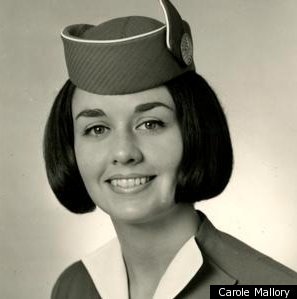
 Seeing the latest segment of the TV show Pan Am brought back memories. As a stewardess in the mid-sixties I was offered my choice of destinations every month. This was the great joy of being a stewardess, choosing between Bangkok, Tehran, Beirut, Paris, London, Rome, Johannesburg and many more. As a novice stewardess, I felt an adrenaline rush. I jumped on plane to Berlin.
Seeing the latest segment of the TV show Pan Am brought back memories. As a stewardess in the mid-sixties I was offered my choice of destinations every month. This was the great joy of being a stewardess, choosing between Bangkok, Tehran, Beirut, Paris, London, Rome, Johannesburg and many more. As a novice stewardess, I felt an adrenaline rush. I jumped on plane to Berlin.
The flight to Germany was long and tiring, but it was also a way of going home. My mother was Pennsylvania Dutch, a misnomer that came from the word Deutsch, meaning German, so I had Teutonic ancestry.
When I was on any grueling flight, my greatest pleasure was studying Pan Am's map of the world, which I called the candy store. I would sit in the back of the plane next to the god-awful Airwick smells from the lavatory and fantasize about my next trip. When I chose a destination, I would research it in the library.
Berlin was lively and still known for its risqué Cabaret-style clubs, but those establishments held little interest for me. I wanted to see The Wall.
After the plane landed, another stewardess and I grabbed our passports and hightailed it to the first tourist bus to East Berlin. Yes, we took a tourist bus. We were surprised when we arrived at Checkpoint Charlie. Shockingly drab, it had an ominous grey cast. Looking at it conjured the horrors of life in East Berlin.
The checkpoint was at the corner, au coin as the French would say, of Fredickstrasse, Zimmerstrasse and Mauerstrasse, known as the German Wall Street.
As the most visible Berlin Wall checkpoint, Checkpoint Charlie is frequently featured in spy movies and books. A famous cafe and viewing place for Allied officials, Armed Forces and visitors alike, Café Adler was situated right on the checkpoint. It was an excellent viewing point to look into East Berlin while having something to eat and drink.
At the checkpoint the guards came on the bus and checked our passports . The checkpoint was curiously asymmetrical. During its 28-year active life, the infrastructure on the Eastern side was expanded to include not only the wall, watchtower and zigzag barriers, but a multi-lane shed where cars and their occupants were checked. However the Allied authority never erected any permanent buildings, and made do with the well-known wooden shed, which was replaced during the 1980s by a larger metal structure, now displayed at the Allied Museum in western Berlin.
The guardhouse was much like a toll booth on a turnpike. No one was smiling. It was an autumn day and the sky was somber like our feelings.
When we passed the checkpoint, our guide pointed to the desolate grey buildings with no signs of life. They were drab, deserted and reminded me of apartment -building-like -coffins. Maybe five or six stories high, no curtains, no color, no sound, no movement. Silence and immobility represented East Berlin. Stark, bleak. No cafes like on the West. Few cars in transit to who knows where as there was little place to go. Repression of the first order.

Our guide pointed out that the wall was the 830-mile-long border zone that became 3.5 miles wide on its East German side in some parts of Germany.
"Notice this tall steel-mesh fence running along the wall," our guide said. "This is called a 'death strip' bordered by bands of ploughed earth, to slow and to reveal the prints of those trying to escape. It contained mined fields."
As we drove through East Berlin, I felt as though I was visiting life after a tortuous death though little life was visible. Our guide took us to an enormous cemetery to show the graves of those who had tried to escape and bodies of soldiers from the war. Of course it was somber and after awhile boring. Like a detective I wanted to see a soul living in East Berlin and have a conversation with her or with him, but we were not allowed to leave the group. I felt like a prisoner among prisoners.
When we drove away from the cemetery and were returning to Checkpoint Charlie, I looked at the blank windows on the coffin like buildings. I looked for curtains. None. Bodies. None. Listened for voices. None. When we passed through the checkpoint to West Berlin, it was as though someone had turned on a stereo and painted the background. There were people hustling and bustling. Life.
My girlfriend and I sat in the Adler Café and order a café mitt schlag. "What are you thinking?" I asked her.
"How good it is to be free. How good it will be to take a bath. How good it will be to return home to America."
On the returning flight to New York, the loneliness of the passengers and their need to talk to me was welcome. How good it felt that unlike the prisoners of East Berlin they had the freedom of their words and that I had the opportunity to be there for them and to listen to them.